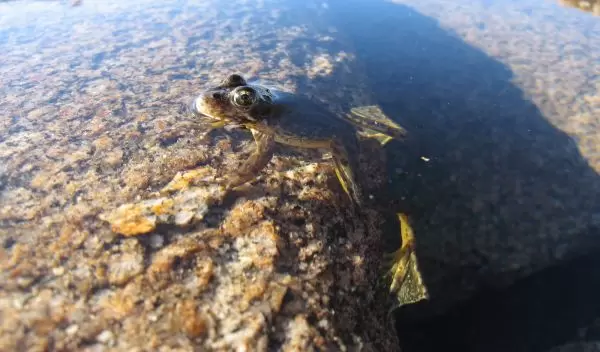
"Microbiome" of Sierra Nevada yellow-legged frogs shifts during infectious disease outbreaks
Find related stories on the NSF, National Institutes of Health and U.S. Department of Agriculture's Ecology and Evolution of Infectious Diseases (EEID) program at this link.
The adult human body is made up of some 37 trillion cells. But microbes, mainly bacteria, outnumber our body's cells by a ratio of 10-to-1.
Scientists now recognize that this huge community of benign microbes--called the microbiome--affects the health, development and evolution of all multicellular organisms, including humans.
Studies show that interactions between such microbiomes and pathogens, or disease-causing microorganisms, can have profound effects on infectious diseases.
In results of a new study, scientists from the University of California, Santa Barbara (UCSB) demonstrate that a fungal pathogen of amphibians does just that. The findings appear this week in the journal Proceedings of the National Academy of Sciences.
Infectious pathogens may disrupt the microbiome
Experiments with model organisms such as mice have shown that infectious pathogens can disrupt the microbiome, but the extent to which this process shapes disease outbreaks is largely unknown.
The work, conducted by scientists Cherie Briggs and Andrea Jani of UCSB, addresses a gap in disease ecology and microbiome research.
"This study shows the importance of knowing how the many benign microbes living on and in our bodies interact with those that cause disease," says Sam Scheiner, National Science Foundation program director for the joint NSF-NIH-USDA Ecology and Evolution of Infectious Disease Program, which funded the research.
"The results are important for developing responses to a disease that's causing amphibians to go extinct worldwide," says Scheiner, "and have implications for future studies of human health."
Jani and Briggs found that the fungus Batrachochytrium dendrobatidis (Bd) drives changes in the frogs' skin microbiomes during disease outbreaks in four populations of the Sierra Nevada yellow-legged frog (Rana sierrae).
Chytridiomycosis, an infectious disease of amphibian skin caused by the Bd pathogen, is a leading cause of amphibian losses worldwide.
"Since amphibian skin is the organ infected by Bd, there has been a lot of interest in how anti-fungal properties of some skin bacteria may protect the frogs," says Briggs.
"We focused on the flip side of this interaction: how infection with Bd can disrupt the skin microbial community."
Next-generation DNA sequencing documents changes
"We used next-generation DNA sequencing to document shifts in skin bacteria communities of the frogs during Bd outbreaks," Jani says.
"We paired field surveys with laboratory infection experiments, demonstrating a causal relationship in which Bd altered the frog's microbiome."
The researchers found that the severity of infection with Bd is strongly correlated with the composition of bacteria communities on the frogs' skin.
"It was surprising that across the different frog populations, there was a striking consistency in the correlation with Bd," says Jani.
One of the populations crashed due to Bd infection, but the other three populations tolerated Bd infections.
"There are different disease dynamics going on," says Jani, "yet there's a similar relationship between the microbiome and Bd."
Answers still elusive
The researchers were unable to conclusively determine whether the Bd-induced disturbance of the frog skin microbiome contributed to the disease symptoms.
The pathogens may interact with the microbiome directly or by manipulating the frogs' immune systems.
It's possible, the biologists say, that the pathogens directly compete with certain bacteria for space or resources or release compounds that affect some bacteria species.
Or the pathogens may control frog immune responses to favor their own growth and disrupt the normal microbiome.
The researchers say that promise exists for probiotic treatments as a way of fighting the decline of frogs due to Bd, but they're careful to qualify the statement.
There is a lot they still don't understand about the environmental effects of such treatments or the interactions between the frogs' microbiomes and the Bd pathogen.


